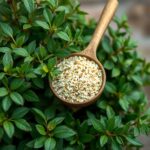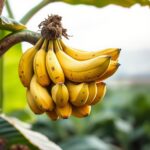Which Plants Do Not Like Epsom Salt? A Complete Guide for Gardeners

Epsom salt, composed of magnesium sulfate, is a popular ingredient among gardeners for its potential benefits to various plants. However, not all plants thrive in the presence of this compound. Understanding which plants do not favor Epsom salt is crucial for maintaining a healthy garden. This complete guide will explore the specific types of plants that can be adversely affected by Epsom salt, the reasons behind their sensitivity, and alternative care suggestions. Whether you are a seasoned gardener or a novice, this information will help you make informed decisions to optimize your gardening practices and ensure plant health.
Which Plants Do Not Like Epsom Salt?
Many gardeners use Epsom salt as a magnesium and sulfur supplement for their plants; however, not all plants benefit from it. Certain species, particularly those that prefer a more acidic or neutral pH, may experience negative effects when exposed to Epsom salt. For example, plants such as azaleas, rhododendrons, and some fern varieties can be sensitive to the additional magnesium, which can lead to nutrient imbalances and hinder overall growth. It's crucial for gardeners to research and understand the specific needs of their plants to avoid using Epsom salt on those that do not thrive with it.
Azaleas
Azaleas are known for their beautiful blooms and are sensitive to soil composition. The introduction of Epsom salt can alter the pH levels of their preferred acidic soil, potentially leading to nutrient deficiencies. This imbalance might result in poor flowering or leaf discoloration, often manifesting as yellowing leaves.
Rhododendrons
Similar to azaleas, rhododendrons thrive in acidic environments. Epsom salt, due to its magnesium content, can disturb the delicate balance of nutrients in the soil. Adding it can lead to reduced growth and flowering, negatively impacting the overall health of these plants and making them prone to diseases.
Ferns
Ferns are typically moisture-loving plants that prefer shade and a specific range of nutrients. Epsom salt can be detrimental, as it may lead to over-fertilization and excessive salinity in the soil. This can cause root burn and hinder the fern's ability to absorb water properly, resulting in wilting or browning of the fronds.
Carnivorous Plants
Many carnivorous plants, like Venus flytraps, thrive in nutrient-poor, acidic soils. Epsom salt can introduce excess magnesium and other minerals that these plants cannot process. As a result, the plants may suffer chemical stress, affecting their growth and ability to catch prey.
Plantain Lily (Hosta)
The Plantain Lily, or Hosta, enjoys rich, well-draining soil but does not require additional magnesium. Utilizing Epsom salt can inadvertently raise magnesium levels too high, which can inhibit the plant’s capacity to absorb other necessary nutrients like calcium. This over-saturation can lead to stunted growth and overall poor health.
| Plant Name | Reason for Sensitivity |
|---|---|
| Azaleas | Affected by pH balance changes in acidic soil. |
| Rhododendrons | Disturbance to nutrient balance can occur from excess magnesium. |
| Ferns | Over-fertilization can lead to salinity and root burn. |
| Carnivorous Plants | Excess minerals disrupt nutrient absorption and growth. |
| Plantain Lily (Hosta) | High magnesium levels can impede calcium absorption. |
What plants should I not put Epsom salt on?

Epsom salt, composed of magnesium sulfate, is commonly used as a fertilizer to promote plant growth and improve nutrient absorption. However, not all plants benefit from its application. Here are some plants you should avoid applying Epsom salt to, as it may lead to adverse effects or nutrient imbalances.
1. Plants Sensitive to High Magnesium Levels
Certain plants are sensitive to elevated levels of magnesium, which can lead to nutrient imbalances in the soil. Avoid using Epsom salt on:
See also:
- Roses: While they can benefit from magnesium, too much can hinder iron absorption.
- Tomatoes: Excessive magnesium can lead to calcium deficiency, resulting in blossom end rot.
- Potatoes: High magnesium can disrupt potassium uptake, leading to poor tuber development.
2. Leguminous Plants
Legumes, such as beans and peas, naturally fix nitrogen in the soil. Epsom salt may disrupt this process:
- Beans: Applying Epsom salt may inhibit the natural nitrogen-fixing bacteria.
- Peas: Excess magnesium can lead to iron and manganese deficiencies, affecting growth.
- Clovers: Like other legumes, they thrive without the added magnesium from Epsom salt.
3. Plants Prone to Root Burn
Certain plants have delicate root systems that can suffer from the high salt concentration found in Epsom salt:
- Orchids: Their sensitive roots can be damaged by the salt, leading to root rot and poor growth.
- Sensitive Houseplants: Such as Ferns, which thrive in low-salt environments.
- Seedlings: Young plants may not tolerate the high concentration of minerals in Epsom salt.
4. Acid-Loving Plants
Some plants prefer acidic soil conditions and adding Epsom salt may alter the pH balance:
- Blueberries: They thrive in acidic soils and could suffer from changes in pH.
- Camellias: These plants also prefer acid conditions and may face nutrient lockout.
- Azaleas: Inconsistent pH levels can negatively affect their growth and flowering.
5. Plants Already High in Magnesium
Certain plants are naturally high in magnesium, and additional Epsom salt can lead to toxicity:
- Spinach: Known for its high magnesium content, additional salt can be detrimental.
- Kale: Excessive magnesium can lead to an imbalance in essential nutrients.
- Beets: They can absorb too much magnesium, affecting growth and taste.
Why should you not use Epsom salt in your garden?

Using Epsom salt in your garden might seem like a natural choice to enhance plant growth due to its magnesium and sulfate content. However, there are several reasons why it may not be the best option for your garden. Here are some key points to consider:
Potential Nutrient Imbalance
Adding Epsom salt can lead to a nutrient imbalance in the soil. While magnesium is essential for plant health, too much can adversely affect the absorption of other critical nutrients, such as calcium and potassium. This imbalance can result in various plant health issues, including:
- Inhibition of nutrient uptake
- Reduced plant vigor
- Increased susceptibility to diseases
Soil Chemistry Alterations
Epsom salt can change the chemistry of the soil, affecting its overall health. Over time, the introduction of excessive magnesium can lead to soil salinity issues, which can be detrimental to plant life. Here’s how:
- Disruption of soil microbial activity
- Altered pH levels
- Reduced water retention capacity
Overuse Consequences
Many gardeners may believe that Epsom salt is harmless and can be used liberally. However, excessive use can lead to practical consequences, such as:
- Accumulation of magnesium in the soil
- Root damage to plants
- Long-term degradation of soil structure
Misguided Application Rationale
Applying Epsom salt with the idea that all plants benefit from it is a misguided approach. Not all plants require extra magnesium, and unnecessary application can lead to:
See also:
- Wasting resources
- Potential harm to sensitive plants
- Misallocation of gardening budget towards ineffective solutions
Better Alternatives for Soil Health
Instead of relying on Epsom salt, consider using more suitable alternatives that improve overall soil health. Effective options include:
- Compost for nutrient enrichment
- Mulch to retain soil moisture
- Cover crops to enhance soil structure and prevent erosion
Can I put Epsom salts on all plants?

Epsom salts, chemically known as magnesium sulfate, can be beneficial for many plants, but they are not suitable for all species. Using Epsom salts can enhance plant growth by providing essential nutrients, particularly magnesium and sulfur, which are important for chlorophyll production and overall plant health. However, some plants do not require these added nutrients and can actually be harmed by excessive magnesium levels. It is essential to understand the specific needs of each plant type before applying Epsom salts.
1. Benefits of Epsom Salts for Plants
Epsom salts can provide several important benefits for plants:
- Improves Nutrient Uptake: Magnesium helps plants absorb nutrients more efficiently.
- Enhances Photosynthesis: The magnesium in Epsom salts is vital for chlorophyll production, enhancing the photosynthetic process.
- Aids in Seed Germination: Epsom salts can promote better seed germination and overall plant growth.
2. Plants That Benefit from Epsom Salts
Certain plants are particularly responsive to Epsom salts, benefiting from the added magnesium and sulfur:
- Tomatoes: They thrive with additional magnesium for stronger growth and better fruit production.
- Peppers: Epsom salts can help improve pepper yields and the quality of the fruit.
- Roses: Applying Epsom salts can lead to more vibrant blooms and healthier growth.
3. Plants That Should Not Receive Epsom Salts
While many plants benefit from Epsom salts, some should definitely avoid them:
- Cacti and Succulents: These plants typically require drier conditions and may struggle with excessive magnesium.
- Leafy Greens: Overapplication can lead to leaf burn due to excess magnesium levels.
- Ornamental Grasses: These plants often do not need additional magnesium and can thrive without Epsom salts.
4. How to Apply Epsom Salts to Plants
Proper application of Epsom salts is crucial to prevent over-fertilization and ensure the best results:
- Dilution: Mix 1 tablespoon of Epsom salts in 1 gallon of water for a standard dilution.
- Timing: Apply during the growing season, preferably when plants are actively growing.
- Frequency: Use every 4-6 weeks for optimal results, but observe plant responses to adjust as necessary.
5. Potential Risks of Using Epsom Salts
There are some risks associated with excessive use of Epsom salts, which can lead to negative outcomes:
- Over-Fertilization: Too much magnesium can disrupt nutrient balance and harm plant health.
- Soil Imbalance: Excessive magnesium might affect soil pH and nutrient availability for other plants.
- Root Damage: Applying Epsom salts indiscriminately can lead to root burn and stress in sensitive plant species.
Questions from Our Readers
Which plants do not like Epsom salt?
Epsom salt is beneficial for many plants, but not all species thrive with its application. Plants such as cacti, succulents, and certain ferns can be negatively affected by additional magnesium, leading to potential nutrient imbalances in their soil.
What are the signs that a plant doesn't like Epsom salt?
If a plant is reacting poorly to Epsom salt, you may observe signs such as yellowing leaves, stunted growth, or even leaf drop. These symptoms often indicate that the plant is experiencing stress due to excess magnesium or alterations in its nutrient absorption.
See also:
Should I avoid using Epsom salt on all indoor plants?
While many indoor plants benefit from Epsom salt, it's wise to avoid using it on plants like orchids, which prefer more precise nutrient levels. Always conduct research on specific indoor species before applying Epsom salt to prevent harm to sensitive plants.
Can Epsom salt stunt the growth of specific vegetables?
Yes, certain vegetables, especially root crops like potatoes and carrots, may experience stunted growth if overexposed to Epsom salt. This is because excessive magnesium can disrupt their nutrient uptake, leading to ineffective growth patterns.

If you want to read more articles like Which Plants Do Not Like Epsom Salt? A Complete Guide for Gardeners, we recommend you check out our Plants category.
Leave a Reply
Related Articles